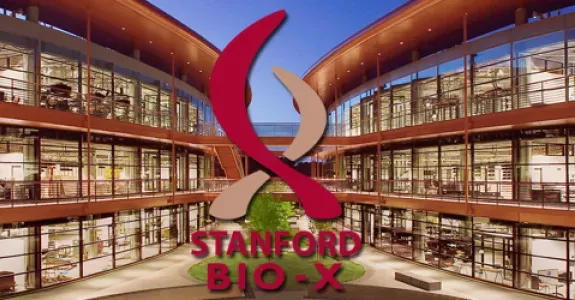
Welcome to the biweekly electronic newsletter from Stanford Bio-X for members of the Bio-X Corporate Forum. Please contact us if you would like to be added or removed from this distribution list, or if you have any questions about Stanford Bio-X or Stanford University.
Highlights
** On October 9, 2013, Bio-X celebrated the 10th Anniversary of the James H. Clark Center, the hub of Bio-X. Check out CLARK CENTER @ 10X on the SPLASH PAGE as well as the Bio-X Timeline over the last 15 years!!
** Check out the article by Stanford President John Hennessy in the Nov/Dec 2013 issue of the Stanford Magazine on Bio-X and the Clark Center, "A Cauldron of Innovation".
Seed Grants
** NEW: Bio-X just announced its 7th round of requests for Letters of Intent for the IIP Seed Grant Program!!
 SEED GRANTS FOR SUCCESS - Stanford Bio-X Interdisciplinary Initiatives Program (IIP)
SEED GRANTS FOR SUCCESS - Stanford Bio-X Interdisciplinary Initiatives Program (IIP)
The Bio-X Interdisciplinary Initiatives Program represents a key Stanford Initiative to address challenges in human health. The IIP awards approximately $3 million every other year in the form of two-year grants averaging about $150,000 each. From its inception in 2000 through the fifth round in 2010, the program has provided critical early-stage funding to 114 different interdisciplinary projects, involving collaborations from over 300 faculty members, and creating over 450 teams from five different Stanford schools. From just the first 5 rounds, the IIP awards have resulted in a 10-fold-plus return on investment, as well as hundreds of publications, dozens of patents filed, and most importantly, the acceleration of scientific discovery and innovation.
In 2012, Stanford Bio-X selected 23 new seed grant projects as the winners of the 6th round. Please go here to view the list of awardees, along with the titles of their projects and the abstracts of the research. Competition was intense as the awardees were chosen from 118 Letters of Intent (LOIs). Selection criteria included innovation, high-reward, and interdisciplinary collaboration. (To view the 114 other IIP projects that have been funded from the first 5 rounds, please click here.) In addition, SANOFI has also funded 4 new Bio-X IIP Seed Grant projects from round 6!
We are cultivating and are highly successful in building meaningful collaborations with numerous corporate colleagues. New collaborations through our seed grant projects are highly encouraged. To learn about how to get involved, please contact Dr. Hanwei Li or Dr. Heideh Fattaey.
** This past Monday, March 3, 2014, Bio-X had a Poster Session, featuring 105 different posters from research by all scientists within the Stanford Bio-X community. Over 250 people attended the session, which allowed for an excellent venue to discuss science and research with colleagues from both academia and industry.
** On Monday, August 26, 2013, Bio-X had its second annual IIP Symposium of the year at the Clark Center, which highlights projects that exemplify the Stanford Bio-X mission of crossing boundaries to bring about interdisciplinary research and solutions in the field of life bioscience. The symposium was a huge success with over 300 people attending this event, which included 8 oral presentations and 136 poster presentations. Recorded talks from the symposium will be uploaded soon. If you'd like to view the talks for previous symposia through the years, please click here.
Fellowships
** NEW: Bio-X is pleased to announce the 11th annual competition for Bio-X Graduate Student Fellowships.
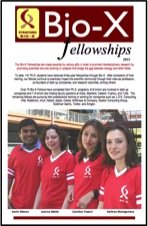 BIO-X FELLOWSHIPS
BIO-X FELLOWSHIPS
Every year, graduate students and postdoctoral scholars of Bio-X affiliated faculty are highly encouraged to apply for the Bio-X Fellowships, which are awarded to research projects that are interdisciplinary and utilize the technologies of different fields to solve different biological questions. Students are encouraged to work collaboratively with professors of different departments, thus creating cross-disciplinary relationships among the different Stanford schools. Our fellows have conducted exciting research, resulting in publications in high-impact journals and have been offered excellent positions in industry and academia. To date, Stanford Bio-X has a total of 152 Fellows.
On June 26, 2013, Bio-X held its annual Bio-X Fellows Symposium, where there were four 15-minute oral presentations followed by one-minute spiels from current fellows. The 25 newest fellows selected this year were also announced, and about 100 attendees came to the symposium. Please click on the "Bio-X Fellows Symposium" link above for the agenda and titles of the talks, and on the icon of the brochure above for the updated and latest Bio-X Fellowships brochure.
To view the numerous projects that have been awarded over the years, please click here.
** NEW: Bio-X is pleased to announce its 9th call for applications for the Undergraduate Summer Research Program for the summer of 2014.
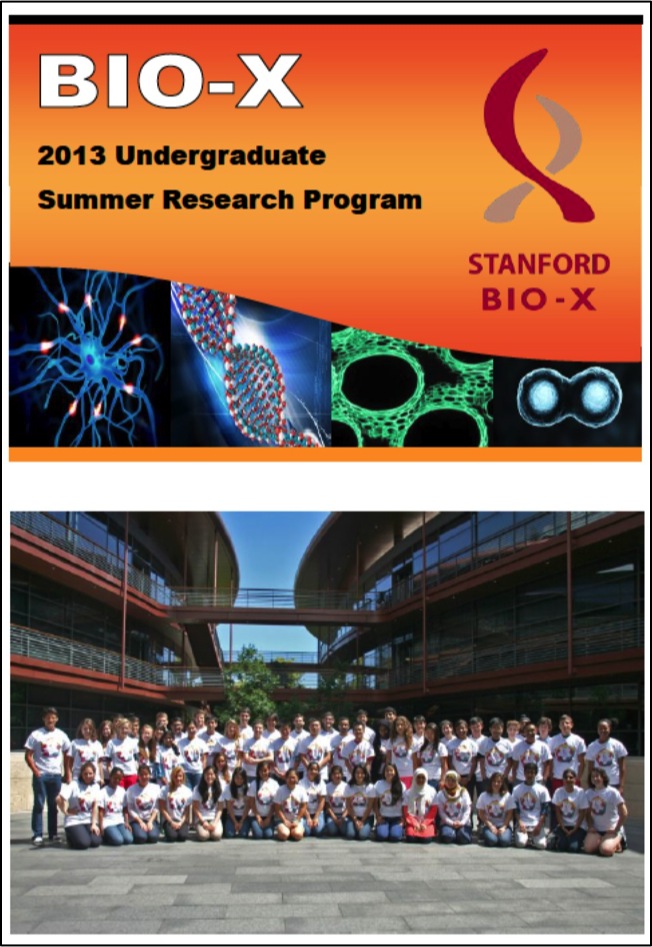 BIO-X UNDERGRADUATE SUMMER RESEARCH PROGRAM
BIO-X UNDERGRADUATE SUMMER RESEARCH PROGRAM
The Bio-X Undergraduate Summer Research Program supports undergraduate research training through an award designed to support interdisciplinary undergraduate summer research projects. The program is an invaluable opportunity for students to conduct hands-on research, learn how to carry out experiments in the laboratory, and develop the skills to read and analyze scientific literature.
This program is eligible to Stanford students who want to work in the labs of Bio-X affiliated faculty. To date, 241 students have been awarded the opportunity to participate in the Bio-X Undergraduate Summer Research Program. This summer is Stanford Bio-X's 8th round of USRP.
Participating undergraduates are also required to present poster presentations on the research that they've conducted during the program. Please click here for title lists of past posters that our undergraduates have presented.
Many fruitful collaborations and relationships have been established with industry through fellowships. Please contact Dr. Hanwei Li or Dr. Heideh Fattaey if you'd like to learn more about how to get involved with these fellowship programs.
News
Stanford researchers identify cellular elastic that keeps nerves resilient
Bio-X Affiliated Faculty Miriam Goodman and Alex Dunn
Bio-X IIP Seed Grant Project
Make a fist, and pity the nerve cells in your hand. Some are stretched taut across the outside of your fingers, and others are squished within your palm. Despite that, they continue to do their jobs, sending signals to detect touch or pain and controlling your muscles to release the fist or clench it tighter. The question is how. If nerves were like floppy strings, the constant bending and stretching could damage their delicate membranes and prevent them from sending signals to and from the spinal cord. Michael Krieg was pondering this issue of nerve resilience when he began studying some tiny roundworms whose nerves buckled and broke over time. The worms had a mutation in a protein called spectrin, and spectrin had long been known to form an elastic lattice under the surface of red blood cells to help them bend and flex as they traverse the circulatory system. Krieg wondered: If spectrin could help provide flexibility to blood cells, could it also help nerves withstand the push and pull of their daily lives? The answer appears to be yes, according to work published Feb. 23 in Nature Cell Biology.
 Researchers develop data-driven methods for analyzing off-label drug use
Researchers develop data-driven methods for analyzing off-label drug use
Bio-X Affiliated Faculty Nigam Shah
Bio-X USRP-Supported Author William Chen
Physicians often prescribe drugs for unapproved indications, but current methods of tracking these off-label uses are limited in scope. Now, a study by researchers at the Stanford University School of Medicine describes a way to extract and sort valuable information about off-label uses from electronic medical records. The study’s authors hope their findings will help to jump-start research into off-label uses that are promising, low-risk and low-cost, as well as flag potentially risky uses for further review. Drugs prescribed for unapproved conditions, dosages or age groups account for 21 percent of all U.S. prescriptions, according to a 2006 investigation published in the Archives of Internal Medicine. But only 27 percent of such uses are supported by robust science. These statistics are not as alarming as they seem at first glance. The lengthy, costly drug-approval process makes a certain amount of off-label drug use inevitable. Off-label prescriptions are legal in most cases and can be an important source of innovation to accelerate new uses for drugs. Nigam Shah, MBBS, PhD, assistant professor of medicine and senior author of the new study, believes better tracking and investigation of off-label use can help patients, physicians and regulators, but should also appeal to drug companies, who will benefit from new approved uses for their products. “Just as detection of abnormal spending is now a routine feature of credit card services, someday off-label use detection could be a routine part of health-care systems,” Shah said. The National Disease and Therapeutic Index relies on physician surveys to monitor off-label prescriptions, but the index is far from comprehensive. “We wanted to describe the whole universe of off-label use,” said Kenneth Jung, a graduate student in biomedical informatics and the lead author of the study, published Feb. 19 in PLOS ONE.
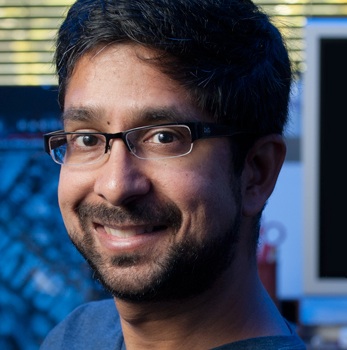 Stanford's Folding@home simulates activation of key cancer protein, could lead to novel drug design
Stanford's Folding@home simulates activation of key cancer protein, could lead to novel drug design
Bio-X Affiliated Faculty Vijay Pande
Once again, computer screensavers have flexed their muscles and solved a great mystery of biology. For the first time, Folding@home, the Stanford-run program that taps the idle processing time of 200,000 personal computers to elucidate the three-dimensional shape of proteins, has simulated a protein transitioning between its inactive and active configurations. The particular protein simulated by the research group, Src kinase, plays an important role in many cancers, and this work provides a novel opportunity for designing future drugs to combat its role in disease. The study, which was led by senior authors Vijay Pande, founder of Folding@home and a professor of chemistry, structural biology and computer science at Stanford, and Benoît Roux, a professor of biochemistry and molecular biophysics at the University of Chicago, was recently published in the journal Nature Communications.
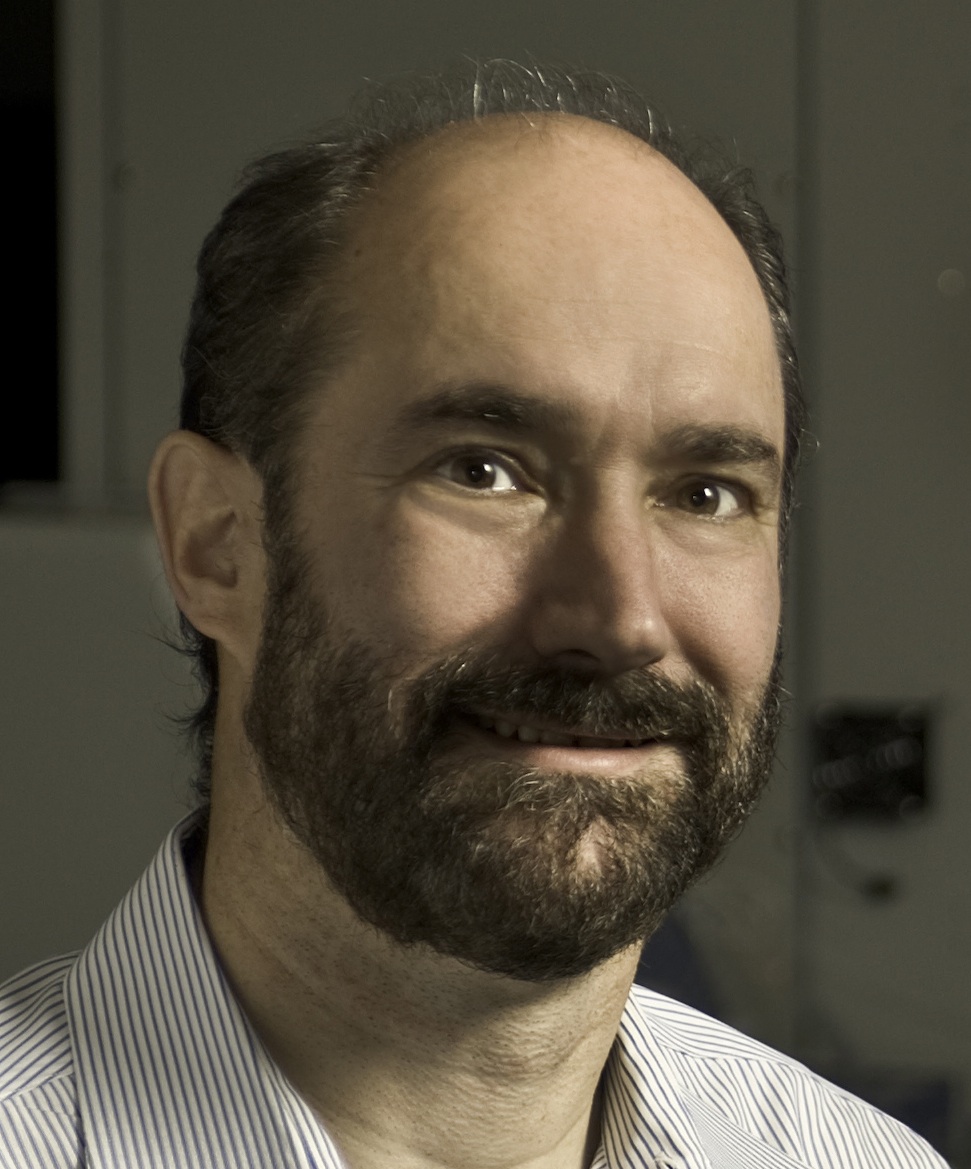 Stanford researchers create a new technique to study how we inherit disease
Stanford researchers create a new technique to study how we inherit disease
Bio-X Affiliated Faculty Michael Snyder
Human reproduction is simple. A sperm cell carries the man’s genome into the egg. There, during fertilization, male and female genomes commingle in a way that fuses different traits from each parent into the DNA blueprint for a new human being. Parents aren’t perfect. Their genomes may contain disease-causing mutations. Nature tries to protect offspring by gene-mixing. This way if one parent passes on a defective mutation, the other has a chance to contribute a working copy. Until now, however, there hasn’t been an easy way to determine whether an offspring inherited a good working copy of a gene or two defective mutations, a scenario that could cause disease or illness. In a recent paper in Nature Biotechnology, a research team led by Stanford scientists and engineers describes a new process that can analyze an offspring’s DNA and reveal which specific genes were inherited from each parent.
 Smartphones become ‘eye-phones’ with low-cost devices developed by ophthalmologists
Smartphones become ‘eye-phones’ with low-cost devices developed by ophthalmologists
Bio-X Affiliated Faculty Robert Chang
Former Bio-X Graduate Fellow Author David Myung
Researchers at the Stanford University School of Medicine have developed two inexpensive adapters that enable a smartphone to capture high-quality images of the front and back of the eye. The adapters make it easy for anyone with minimal training to take a picture of the eye and share it securely with other health practitioners or store it in the patient’s electronic record. “Think Instagram for the eye,” said one of the developers, assistant professor of ophthalmology Robert Chang, MD. The researchers see this technology as an opportunity to increase access to eye-care services as well as to improve the ability to advise on patient care remotely. Ophthalmology resident David Myung, MD, PhD, lead author of two upcoming papers describing the development and clinical experience with the devices, began the project with Chang about two years ago, just before Myung began his residency at Stanford. The papers were published online March 7 in the Journal of Mobile Technology in Medicine.
Researchers' new test for cystic fibrosis may lead to more treatments
Psychology and Biology Professor Jeffrey Wine
Treatments for cystic fibrosis may be faster to develop with the use of a new test created by Stanford researchers. The test, which involves sampling sweat, shows that people need smaller amounts of a particular protein function than previously thought to avoid cystic fibrosis symptoms, according to Jeffrey Wine, PhD, a professor of psychology and of biology. "I was amazed it worked out as well as it did," said Wine, who also is director of Stanford's Cystic Fibrosis Research Laboratory and a member of the Child Health Research Institute at Stanford. Wine and his colleagues, including faculty in the School of Medicine, used the test to measure levels of protein function in patients taking a cystic fibrosis drug. Their findings were published Feb. 10 in PLOS ONE. Wine was the senior author of the study. The lead author was Jessica Char, a life science research assistant.
Events
| Biochemistry March 12, 2014, 4 pm - 5 pm Clark Center Auditorium, Stanford, CA FRONTIERS IN BIOLOGY - "The unfolded protein response in health and disease" Speaker: Peter Walter, UCSF |
Bio-X Seminar March 13, 2014, 4 pm - 5 pm Clark Center Auditorium, Stanford, CA "Cortical interneuron wiring: more nurture than nature" Speaker: Gordon Fishell, NYU School of Medicine |
Resources
| Stanford University |
| Stanford Bio-X |
| Bio-X Seed Grants The Stanford Bio-X Interdisciplinary Initiatives Program (IIP) provides seed funding for high-risk, high-reward, collaborative projects across the university, and have been highly successful in fostering transformative research. |
| Office of Technology and Licensing "Techfinder" Search the OTL Technology Portal to find technologies available for licensing from Stanford. |
| Stanford Center for Professional Development - Take advantage of your FREE membership! - Take online graduate courses in engineering, leadership and management, bioscience, and more. - Register for free webinars and seminars, and gets discounts on courses. |
| Stanford Biodesign Video Tutorials on how FDA approves medical devices A series of video briefs recently produced by the Stanford Biodesign Program teaches innovators how to get a medical device approved for use in the United States. This free, online library of 60 videos provides detailed information on the Food and Drug Administration regulatory process, short case studies and advice on interacting with the FDA. |
To learn more about Stanford Bio-X or Stanford University, please contact Dr. Hanwei Li, the Bio-X Corporate Forum Liaison, at 650-725-1523 or lhanwei1@stanford.edu, or Dr. Heideh Fattaey, the Executive Director of Bio-X Operations and Programs, at 650-799-1608 or hfattaey@stanford.edu.
